
1. The quick list
2. Best for electronic music
3. Best for making beats
4. Best for Mac
5. Best pedigree
6. Best for guitarists
7. Best for value
8. Best second DAW
9. Best for experimentation
10. Best for Mac beginners
11. Best for post-production
12. Best free DAW
13. Best for PC beginners
14. Best DAW for iPad
15. Buying advice
16. How we test
If you make music on a computer, be that a PC or a Mac, your DAW - or Digital Audio Workstation, to give it its full name - is the most important tool in your creative arsenal. As such, finding the best DAW for you is vitally important.
Yes, you’ll likely have a MIDI keyboard, audio interface, set of studio monitor speakers and possibly a microphone or two in your home recording setup as well, but your music production software sits at the centre of everything, and if it's not working for you, your level of creativity is likely to be compromised.
As such, it’s important to get a DAW that you’re happy with - and, perhaps even more importantly, a digital audio workstation that will enable you to turn your ideas into music as quickly and painlessly as possible. Put simply, the best DAW for you is the one that makes it easiest for you to make music, and inspires you to keep creating.
To help you find that DAW, we’ve put together an expert guide to what we consider to be the best Digital Audio Workstations on the market today, including full reviews for many of our choices.
In truth, any one of these products will enable you to make music - and we're not saying that any one is definitively better than all the others - but they’re all slightly different in the way that they operate and there are subtle differences between their feature sets, so it’s worth taking the time to consider your options carefully and try out demo versions wherever possible.
The quick list

It's hard to overstate the impact that Live has had on the music software marketplace. It's not just a recording program for composers, but also a powerful performance instrument and a recent update adds a couple of new features, namely the Meld synth and the Roar colouring/saturation effect, plus a new suite of MIDI tools designed to make it easier to come up with new melodic and harmonic ideas.

View at Image-Line
Image-Line's DAW holds near-iconic status for a certain generation of producers, particularly in the hip-hop and EDM realms. The headline feature is a native 64-bit Mac version, meaning that FL Studio can now be used on macOS (as well as PC) without the need for a clunky workaround. Image-Line offers lifetime free upgrades to FL Studio users, too.

Central to this version of Logic is the addition of Ableton-style Live Loops, which enable you to jam with ideas before recording them to the main timeline. There's also a new step sequencer, completely overhauled samplers and new tools for electronic beatmakers. Apple's DAW also enables you to create tracks in the company's Dolby Atmos-powered spatial audio format.

Despite increased competition, Cubase is still up there at the head of the DAW pack. The latest version, 13, evolves rather than revolutionises the user experience, rocking an overhauled MixConsole, new vocal processing plugins and a simple notation tool. For new purchasers, the many excellent plugins, extensive sound library and massive functionality continue to make Cubase worth the price of admission.
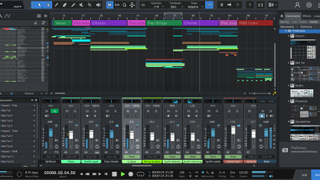
Fuller, fatter and more versatile than the majority of DAWs out there, version 6 takes Studio One to the next level, and ably re-configures itself to suit your needs. There's now Dolby Atmos support in the mix, and a new file format, DAWproject, that's designed to make it easier to share projects between different applications.

Reaper is a remarkably affordable cross-platform DAW that has a tiny footprint and sophisticated MIDI/audio routing capabilities. This is one of the most customisable and affordable DAWs around. What's more, it's wonderfully responsive, with everything from scrolling and zooming to fader moves and item editing feeling quick and fluid.
Load the next 7 products...

Reason 12 boasts a more powerful and flexible Combinator than ever before, hi-res graphics and a new sampler. VST3 support has also been added, and with the arrival of a native version for Apple silicon-powered Macs, users of those machines can expect significant performance boosts
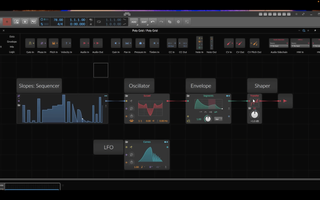
Bitwig Studio has come a long way since launch, throwing off the shackles of its inevitable Ableton Live comparisons - the two share a number of original developers and some significant workflow similarities - by adding multiple features that have bolstered Bitwig’s reputation as possibly the most inventive DAW on the market.

GarageBand has matured into a pretty capable DAW. It’s great for newbies, but dig a little deeper and you’ll find some rather more advanced features, too. Non-musicians can simply sequence the supplied audio loops, but a decent collection of software instruments comes supplied, too, as does multitrack recording functionality and a good selection of virtual guitar amps and stompboxes.
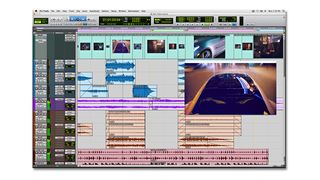
It’s hard to know where to start with Pro Tools, which remains an industry standard in recording studios around the world. The software has never had quite the same impact in the home recording market, but knowledge of it certainly puts you at an advantage if you want to work in the industry.
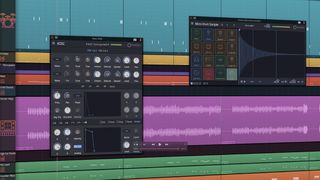
Tracktion’s Waveform free-to-download application isn’t necessarily a unique setup within the DAW market - the likes of Presonus and Avid also offer free, entry-level versions of Studio One and Pro Tools respectively. What sets Waveform apart, however, is how much you get for your no-money, making it one of the best free DAWs out there.

When PC users ask us if it’s possible to get a GarageBand-style application for their operating system, we tend to point them in the direction of Mixcraft. Through its nine major updates, Mixcraft has evolved from a basic starter app to a genuinely impressive DAW, taking on features normally associated with costlier alternatives.

There have been numerous attempts at creating mobile DAWs over the past decade, some of which – such as Cubasis or BeatMaker – have proved genuinely impressive. But the most accomplished iOS music-making environment comes, perhaps unsurprisingly, from the creator of the iPad itself.
Best for electronic music

It's hard to overstate the impact that Live has had on the music software marketplace. When the first version was released in 2001 it threw out the traditional design rulebook and established itself not just as a recording program for composers, but also as a performance instrument in itself. Since then, it's exploded in popularity and influenced the development of countless other desktop and mobile apps.
The latest version, Live 12 is one of the most significant updates to a DAW in recent years. This a couple of big new devices - the Meld synth and the Roar colouring/saturation effect - plus a new suite of MIDI tools that are designed to make it easier to come up with new melodic and harmonic ideas.
Perhaps even more significant are changes to the flexibility of the UI, a modernised browser and enhancement of the overall accessibility. All of this makes Live feel more modern and refreshed, but also opens up it usability to a wider pool of users.
Read the Ableton Live 12 Suite review
Best for making beats

Originally launched as FruityLoops, Image-Line's DAW holds near-iconic status for a certain generation of producers, particularly in the hip-hop and EDM realms.
The headline feature in version 20 was a native 64-bit Mac version, meaning that FL Studio can now be used on macOS (as well as PC) without the need for a clunky workaround. Pleasingly, licenses are shared between both Mac and PC versions.
Image-Line offers lifetime free upgrades to FL Studio users, meaning that all existing users of the software can download new versions on both platforms without paying a penny extra.
And the updates just keep on coming: FL Studio 21 was released towards the end of 2022 and added new audio clip envelopes, themes and plugins. Bringing things right up to date, version 21.2 added a Roland Juno-6 synth emulation and even built-in stem separation, a feature that many of its DAW rivals are lacking (though not for too much longer, we suspect).
With its unique workflow, FL Studio offers a great entry-point into the world of music production, but to say that it's 'only for beginners' would be to do it a major disservice (check out our dedicated best DAWs for beginners guide for more specific examples). If you like its approach, there's no reason why it can't be your DAW for life.
Read the FL Studio 21 review
Best for Mac

It’s been a while since we had a ‘full’ new version of Logic Pro - version X was released way back in 2013 - but numbers can be deceiving. Version 10.5 was Logic Pro 11 in all but name, turning this most traditional of DAWs into a truly contemporary music-making platform.
Central to this overhaul was the addition of Ableton-style Live Loops, which enable you to jam with ideas before recording them to the main timeline. There was also a new step sequencer, completely overhauled samplers and new tools for electronic beatmakers.
As of Logic Pro 10.7, Apple's DAW enables you to create tracks in the company's Dolby Atmos-powered spatial audio format. There are new mixer and panner controls for this, and 12 other Logic Pro plugins are now spatial audio-ready, too.
And there's more: there's now an excellent iPad version of Logic Pro that, while not a direct replacement for the desktop version, is a brilliant music production application in its own right. And some of its best features - the likes of the Sample Alchemy and Beat Breaker plugins - were added to the Mac version as part of the Logic Pro 10.8 update, alongside a new automatic Mastering Assistant.
Aside from all that, Logic Pro remains superb value for money. For the price, Mac users won’t find a more comprehensive set of music production tools anywhere else.
Read the Apple Logic Pro 10.7 review
Best pedigree

Steinberg has spearheaded music software development for over 30 years, and through Cubase, which started as a MIDI sequencer, introduced a whole generation to the block-based arrange screen now used in the majority of today’s DAWs.
Along the way, the company also invented virtual studio technology (VST), developed a class-leading audio editor (WaveLab) and survived the dark days of software piracy.
Despite increased competition, Cubase is still up there at the head of the DAW pack. The latest version, 13, evolves rather than revolutionises the user experience, rocking an overhauled MixConsole, new vocal processing plugins and a simple notation tool.
For new purchasers, the many excellent plugins, extensive sound library and massive functionality continue to make Cubase worth the price of admission, and it's worth noting that the more affordable Artist and Elements editions come with decent feature sets, too. All of which is to say that the Cubase train shows no sign of slowing just yet.
Read the Steinberg Cubase Pro 13 review
Best for guitarists

Studio One has been gaining ground for several years, and it's now a DAW of real power and maturity, not merely matching its rivals in most respects but going beyond them in a few areas.
Following the 'coming of age' release that was version 5 - this included a fully developed score editor and Clip Gain Envelopes for surgical region-based volume automation - version 6 added Smart Templates that are designed to quickly get you started on a specific task, the ability to customise the interface, lyric support, a Global Video Track and new plugins.
Version 6.5, meanwhile, threw Dolby Atmos support into the mix, and also introduced a new file format, DAWproject, that's designed to make it easier to share projects between different applications. This only works in Studio One and Bitwig Studio at the moment, but if it gets adopted more widely, it could turn out be very useful.
Fuller, fatter and more versatile than the majority of DAWs out there, version 6 takes Studio One to the next level, and ably re-configures itself to suit your needs.
It's a great option for guitar players, but we have more options in our guide to the best DAWs for guitarists.
Read the PreSonus Studio One 6 review
Best value

For the benefit of those not in the know, Reaper is a remarkably affordable cross-platform DAW that has a tiny footprint and sophisticated MIDI/audio routing capabilities.
This is one of the most customisable and affordable DAWs around. What's more, it's wonderfully responsive, with everything from scrolling and zooming to fader moves and item editing feeling quick and fluid. Reaper 7 demonstrates that the software is still moving with the times, thanks to the addition of Track Lanes (use them to manage takes, layer sounds, assemble alternate track versions or store playlists), Swipe Comping (for fast assembly of multiple takes), FX Containers (create your own chains) and more track channels and MIDI I/O.
Factor in some budget for the soundware of your choice and Reaper makes for a top-class music production environment, and with a free 60-day evolution period, you're given plenty of time to find that out for yourself.
Find out more: Cockos Reaper 7
Best second DAW

Reason has undergone some big changes over the past few years. In 2019, its developer, Propellerhead Software, became Reason Studios, and version 11 of the rack-based DAW was released. This introduced the Reason Rack Plugin, which enables the DAW’s core tools to be used as a VST 3 or AU plugin within another DAW.
Of course, you can still use Reason as your main DAW, but with the stock instruments and effects now available to use anywhere you like, and a new MIDI Out device for controlling your external gear, this is the most attractive that the software has looked in years.
Reason 12 sweetens the deal still further, with a more powerful and flexible Combinator, hi-res graphics and a new sampler. VST3 support has also been added (as of version 12.5), and the arrival of a native version for Apple silicon-powered Macs (version 12.6), users of those machines can expect significant performance boosts
The software is now available on subscription, too, via the Reason+ service.
Read the Reason Studios Reason 12 review
Best for experimentation

Has it really been almost a decade since the release of the first version of Bitwig Studio? It has indeed, though that still makes it a relative infant in DAW terms.
The application has come a long way in that time, though, throwing off the shackles of its inevitable Ableton Live comparisons - the two share a number of original developers and some significant workflow similarities - by adding multiple features that have bolstered Bitwig’s reputation as possibly the most inventive DAW on the market.
That said, version 4, was most notable for the introduction of a pretty fundamental feature: comping. This is handled in a typically elegant, 'Bitwiggy' way, though, and if you're looking for new 'creative' functionality, consider Operators, which add a new and very powerful dimension to how and when MIDI or audio events are triggered.
Version 5, meanwhile, offers an all-new browser, modulators in the mixer, Remote Controls on the track and project, new clip launcher features and, perhaps most importantly, additional MSEGs (Multi-Stage Envelope Generators).
This is all in addition to The Grid, Bitwig Studio's own built-in modular environment, which helps to make the software feel as much like an instrument as it does a recording package. In fact, if you want to experiment, you could argue that Bitwig's DAW is a good as it gets.
Read the Bitwig Studio 5 review
Best for Mac beginners

More than 20 years after a fresh-faced John Mayer helped to launch it at Macworld, GarageBand has matured into a pretty capable DAW. Sure, it’s great for newbies, but dig a little deeper and you’ll find some rather more advanced features, too.
Non-musicians can simply sequence the supplied audio loops, but a decent collection of software instruments comes supplied, too, as does multitrack recording functionality and a good selection of virtual guitar amps and stompboxes. Drummer is great for automatically generating beats, Smart Controls make for more pleasant editing of sounds, and you can even use the Logic Remote iPad app to control the software.
As a further bonus, projects are compatible with Logic Pro, GarageBand’s big brother, and also with the iOS version of GarageBand, giving you a mobile option. And the fact that it’s free means that every Mac owner should try it.
Our only real criticism is that the software hasn't received a major update in a while; if Apple could bring a new of the newer Logic Pro features across (as it has done in the past), GarageBand users might find that they never need to look anywhere else.
Best for post-production

It’s hard to know where to start with Pro Tools, which remains an industry standard in recording studios around the world. The software has never had quite the same impact in the home recording market, but knowledge of it certainly puts you at an advantage if you want to work in the industry.
2022 saw the biggest update of the Pro Tools line in years, with a new free version - Pro Tools Intro - using the same installer as the full software, meaning that it's fully compatible. This version added ARA 2 support for direct integration with Melodyne, and Aux I/O, a macOS-exclusive feature that enables flexible routing of audio between Pro Tools and other software/hardware.
The fun continued last year, when Avid introduced Pro Tools Sketch. Both a free iPad app and a new window in Pro Tools, this presents you with an Ableton Live style clip launching interface that enables you to move away from a linear workflow to something that, for some people, will feel liberating.
Pro Tools is moving with the times, then, and you've dismissed the software before, now could be a good moment to take another look.
Find more more: Avid Pro Tools
Best free DAW
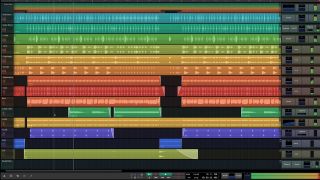
Tracktion’s Waveform application comes in two versions – the paid-for Waveform Pro, and the free-to-download Waveform Free. This isn’t necessarily a unique setup within the DAW market, the likes of Presonus and Avid also offer free, entry-level versions of Studio One and Pro Tools respectively. What sets Waveform apart, however, is how much you get for your no-money, making it one of the best free DAWs out there.
The free version of Waveform is capable of working with both MIDI and audio tracks. It comes complete with several sample-based instruments, a suite of capable audio effects and clip-based sequencing tools that are great for electronic production. It’s compatible with VST and AU plugins too, meaning you can easily expand its stock arsenal of tools.
Tracktion does offer plenty of upgrade options to tempt you to part with your money – ranging from sound packs and construction kits to packs of MIDI and audio tools aimed at a variety of use cases. Despite this though, Waveform Free doesn’t feel like it merely exists as a gateway to its paid counterpart. For casual and beginner users in particular, there’s more than enough here to get your teeth into.
Best for PC beginners

When PC users ask us if it’s possible to get a GarageBand-style application for their operating system, we tend to point them in the direction of Mixcraft. Through its nin major updates, Mixcraft has evolved from a basic starter app to a genuinely impressive DAW, taking on features normally associated with costlier alternatives.
Mixcraft 10 is notable for its new interface, which promises to be easier to navigate. Menus have been simplified, and the project start window, plugin manager, piano roll, automation tools, libraries, and mixer panels have all been enhanced. There are more customisation options, too, along, with an integrated Mixcraft Store that enables you to purchase new content from within the application.
It might not be the flashiest DAW on the market, but if you invest in Mixcraft you'll be getting a well-supported production solution that comes at a great price, and newcomers will find it very approachable.
Read more about Acoustica Mixcraft 10
Best for iPad

There have been numerous attempts at creating mobile DAWs over the past decade, some of which – such as Cubasis or BeatMaker – have proved genuinely impressive. But the most accomplished iOS music-making environment comes, perhaps unsurprisingly, from the creator of the iPad itself.
Logic Pro for iPad is built on what Apple has learned from years of developing GarageBand for iOS. Much like its entry-level sibling, the iOS version of Logic benefits from making the most of the touchscreen control surface, rather than simply trying to replicate the desktop workflow. This is done through a simplified user interface with fewer menus, as well as the inclusion of some genuinely excellent ‘touch’ optimised instruments like Sample Alchemy and Beat Breaker. It works very effectively with Apple’s Pencil accessory too.
What’s most impressive about Logic for iPad is how little functionality is lost as a result of this optimisation. Desktop users will recognise the DAW’s many staple instruments, tools and effects, and AUv3 compatibility means that it can even host compatible third-party plugins. Honestly, our only criticism is that Logic for iPad is subscription only, with no option for outright purchase.
Read the full Logic Pro for iPad review
Buying advice

What is a DAW?
DAWs - or Digital Audio Workstations - are programs you can use to create, record, edit and arrange music.
At the heart of almost every DAW lies something called a sequencer - in fact, sequencers are such an integral part of DAWs that you'll often hear a DAW simply referred to as a sequencer.
Early sequencers were big, clunky hardware devices used to tell other hardware devices (such as drum machines and keyboards) what to play, using a type of performance message called MIDI.
You would first program the sequencer, which would in turn send the MIDI data (containing instructions for what notes to play and when) to outboard devices, which would then interpret the data and turn it into sound.
Indeed, you would 'sequence' a whole song in this way, which would be played back and then recorded to tape.
Modern sequencers are not fundamentally different, but because they're software-based and incorporated into a powerful DAW, they're much more flexible. You can change parts and move them around far more easily, and record actual sounds (audio) as well as sending and receiving MIDI. You can also play software instruments - you usually get some of these with your DAW - and apply effects (again, you usually get some of these bundled in)
Sequencers are used to organise several instruments or parts, and each of these parts is loaded onto a 'track'. Therefore, a 64-track sequencer would enable you to have up to 64 different parts playing in unison.
The performance information for each track is usually mapped out on a timeline, a space in which time is displayed horizontally and tracks are displayed vertically. When you press play, a vertical line called a playhead moves through the song from left to right, and when it reaches an event within a track, the associated sound is heard.
The transport controls contain everything from the standard play, pause and record buttons to repeat (or looping) controls and more.
To adjust the volume of each of the tracks, your DAW also contains a mixer. A hardware mixer is a device used to balance the volumes of separate sound sources, and combine or 'mix' them all to be played through just one set of speakers.
The software equivalent in a DAW works on exactly the same principle. Each of the sequencer's tracks has something called a channel strip, and each track's channel strip is where the volume, panning (where the sound sits in the stereo field, ie, left or right), routing (where the sound comes from and goes to) and more are all controlled.
Each channel strip also has a few buttons such as mute, solo and record arm/enable.
Almost all DAWs also support plugins - additional effects and instruments that can be loaded in used in your productions. These come in a range of formats and can massively expand your sonic horizons.
How do I choose a DAW?
As we’ve already noted, the best DAW for you is the one that you find it easiest to make music with, so it’s worth trying demos of all the software that you’re considering. Think carefully about how you’re going to work, and the elements of the digital audio workstation that are most important to you.
A DAW can be used throughout the music production process: for recording, editing, arranging, mixing and even mastering. If you can, try working through this process - demo versions of many DAWs are available - so that you can test the workflow. If you frequently find yourself struggling and are constantly consulting the manual, the software you’re using probably isn’t for you, and it could be time to look elsewhere.
It goes without saying that, before you buy, you should also make sure that your prospective DAW is compatible with your computer, any other hardware that you might have, and any plugins that you consider essential to your workflow.
Find out more about how we test music gear and services at MusicRadar.
How we test the best DAWs
Here at MusicRadar, we are experts in our field, with many years of playing, creating and product testing between us. We live and breathe everything music gear related, and we draw on this knowledge and experience of using products in live, recording and rehearsal scenarios when selecting the products for our guides.
When choosing what we believe to be the best DAWs available right now, we combine our hands-on experience, user reviews and testimonies and engage in lengthy discussions with our editorial colleagues to reach a consensus about the top products in any given category.
First and foremost, we are musicians, and we want other players to find the right product for them. So we take into careful consideration everything from budget to feature set, ease of use and durability to come up with a list of what we can safely say are the best DAWs on the market right now.
Find out more about how we test music gear and services at MusicRadar.
Related buyer's guides
MusicRadar's got your back
- Our guide to the best budget PCs for music production
- Take a look at the best audio interfaces
- Tweak your mix with the best studio monitors
- The best MIDI keyboards
- Mix it up with our pick of the best studio headphones


